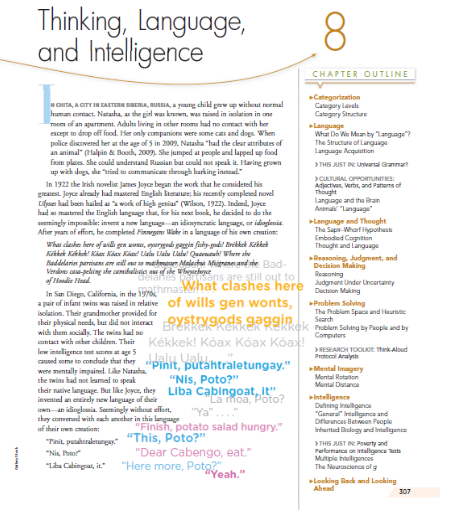Chapter 8. Thinking, Language, and Intelligence
8.1 Introduction


8.2 Slide 2
Welcome to your Try This! research experience for Chapter 8. As you learned in the chapter, in this activity, you will be presented with some of the actual problems that researchers have used to discover how people think and make decisions.
In a moment, you’ll be asked to solve three brief problems. You’ll receive feedback at the end of each.
When you are ready, click “Next”.
8.3 Slide 3
This problem comes from a study in which the researchers were interested in the frequency of appearance of letters in the English language. The researchers selected a popular novel and recorded how often various letters of the alphabet appeared in the first and third positions in words. They excluded words of less than three letters.
You will be given several letters of the alphabet, and you will be asked to judge whether these letters appear more often in the first or in the third position.
8.4 Slide 4
Consider the letter R. Is R more likely to appear in (click one):
| A. |
| B. |
8.5 Slide 5
Consider the letter K. Is K more likely to appear in (click one):
| A. |
| B. |
8.6 Slide 6
Consider the letter L. Is L more likely to appear in (click one):
| A. |
| B. |
8.7 Slide 7
Consider the letter N. Is N more likely to appear in (click one):
| A. |
| B. |
8.8 Slide 8
Consider the letter V. Is V more likely to appear in (click one):
| A. |
| B. |
8.9 Slide 9
You’re finished with the first problem.
Across the five letters you saw, you judged that ___% would be more likely to appear in the first position in a word.
In the study that inspired this Try This! activity (Tversky & Kahneman, 1973), nearly 70% of participants judged the first position to be more likely for a majority of these letters. But in fact, all of these consonants appear more frequently in the third position in words than in the first position. Can you figure out why participants tend to misjudge this?
When you’re ready to try the second problem, click “Next”.
8.10 Slide 10
For this next problem, you’ll be asked to read a description of a person and to answer a question based on that description.
8.11 Slide 11
Linda is 31 years old, single, outspoken and very bright. She majored in philosophy. As a student, she was deeply concerned with issues of discrimination and social justice, and also participated in anti-nuclear demonstrations.
Which is more probable?
| A. |
| B. |
Most people choose B (Tversky & Kahneman, 1983) Did you? However, the correct answer is A. Do you know why?
You’ll learn more about this problem when you return to the text. There is still a third problem to solve.
8.12 Slide 12
In this third problem, you will be asked to estimate the monetary value of a product.
The product is a box of 20 individually-wrapped Belgian chocolates. Belgium is internationally renowned for the quality of its chocolate, quality that is largely due to strict rules about the minimum proportion of cocoa that must be used. These chocolates are lovingly made by hand and include three varieties: buttercreams, caramels, and truffles.
8.13 Slide 13
For reasons which will become clear shortly, please enter the last two digits of your social security number to proceed. If you do not have a social security number or cannot remember it, enter the last two digits of your phone number (or any two digits).

8.14 Slide 14
Imagine you have some gift money available and are interested in the box of 20 Belgian chocolates. Would you be willing to pay $___ for them?
8.15 Slide 15
What is the maximum number of dollars you would be willing to pay for the Belgian chocolates?

8.16 Slide 16
Why were you asked to provide the last two digits of your social security number (or another number) prior to making your bid?
Past research (Ariely et al., 2003) shows that, surprisingly, the number entered affects the amount that people are willing to pay. The following graph illustrates this. People were willing to pay a little less than $10 when the two digits they wrote down were very low and a little over $20 when the two digits were very high!

8.17 Slide 17
Do you see a correlation between your two-digit number (__) and how high or low your bid was (___)? You will learn more about why a seemingly irrelevant number might affect answers when you return to the chapter.
8.18 Slide 18
You have completed the activities in this chapter’s Try This!
When you return to the chapter, you will learn more about how people make decisions and judgments like you just did.
These activities based on and inspired by:
Tversky, A., & Kahneman, D. (1973). Availability: A heuristic for judging frequency and probability. Cognitive Psychology, 5, 207-232.
Tversky, A., & Kahneman, D. (1983). Extensional versus intuitive reasoning: The conjunction fallacy in probability judgment. Psychological Review, 90 (4), 293-315.
Ariely, D., Loewenstein, G., and Prelec, D. (2003). Coherent arbitrariness: Stable demand curves without stable preferences. Quarterly Journal of Economics, 118 (1),73-105.